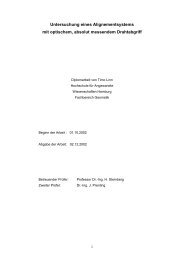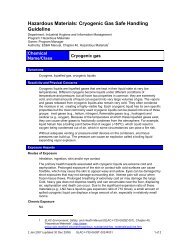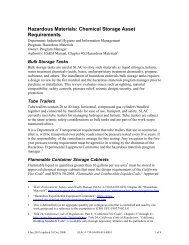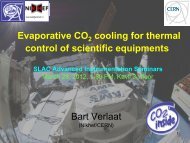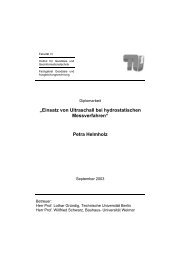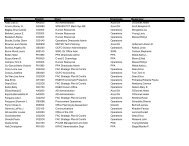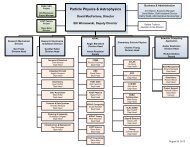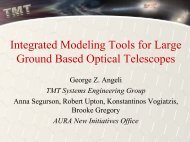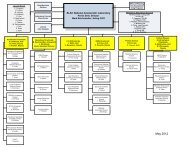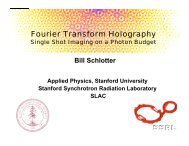BES - SLAC Group/Department Public Websites - Stanford University
BES - SLAC Group/Department Public Websites - Stanford University
BES - SLAC Group/Department Public Websites - Stanford University
You also want an ePaper? Increase the reach of your titles
YUMPU automatically turns print PDFs into web optimized ePapers that Google loves.
FYO7 <strong>SLAC</strong> S CIENCE AND T ECHNOLOGY S ELF E VALUATION<br />
Macromolecular Crystallography: When Roger Kornberg began using synchrotron radiation for<br />
his research on RNA polymerase around 1998, which led to his 2006 Nobel Prize, it was clear that a<br />
large amount of crystal screening at SSRL was needed for the research to move significantly forward.<br />
More efficient use of beam time accommodated this need. This was a decision with significant risk at<br />
the time that resulted in a very significant pay-off.<br />
Development of Research Using Circularly Polarized Radiation: SSRL is currently installing a<br />
new beam line (BL13) to provide circularly polarized radiation for programs in chemical physics of<br />
surfaces and liquids, the resonant coherent x-ray scattering and scanning tunneling microscopy of<br />
magnetic films. These programs were being threatened by delays of over a year due to vendor<br />
problems in quality control in producing the undulator for this beam line. However, we were able to<br />
move and reconfigure an existing undulator from BL5 that also produces circularly polarized x-rays<br />
although over a narrower energy range than what will ultimately be desired. It should be noted that<br />
this undulator was originally developed in-house over 10 years ago. That decision, both risky and<br />
innovative at the time, allowed us to get the research started early in FY07, well before the new beam<br />
line was installed, by using part of BL5, and continue it without interruption on BL13 while the new<br />
undulator is being completed.<br />
Molecular Environmental and Interface Science (MEIS): SSRL continues to be a world leader in<br />
the field of MEIS both by significantly contributing to the beginning of the field as well as<br />
continuing to the present with a growing user community that takes advantage of existing beam lines<br />
(such as BL11-2, 7-2, 10-2 and 2-3), new beam lines such as BL4-1 and a future beam line for nanofocusing<br />
spectroscopy that will be proposed within the next year.<br />
Development of Resonant Coherent X-ray Scattering: This is an area which has the potential for<br />
high risk and high reward. Current developments include methods of imaging magnetic systems<br />
using Fourier transform holography techniques as well as ways of improving the signal to noise of<br />
this method using multiple scattering points. With the development of BL13, this facility will have a<br />
permanent home and will continue to attract a broad international user community.<br />
XAS for Structural Molecular Biology (SMB) and Material/Chemical Sciences: SSRL has a<br />
world class XAS program that serves both an external and internal user community and receives high<br />
marks in external peer reviews. The research quality depends on developments by SSRL staff in<br />
beam line stability, sample environments and detector developments. These new capabilities are<br />
continuing with the development of single crystal XAS that adds the capability of using the<br />
polarization of the beam to highlight particular bonds and determine their structure.<br />
Development of New Research Centers: SSRL has been the source of new developments in the<br />
area of photon science at <strong>SLAC</strong> that have come to fruition in FY07. The X-ray Laboratory for<br />
Advanced Materials (XLAM) now has its own section in this report. LCLS originated as a long term,<br />
risky endeavor within SSRL and has resulted in the construction of the world’s first x-ray free<br />
electron laser (XFEL). As a result of the attention being focused on the LCLS developments by the<br />
<strong>SLAC</strong> staff, an idea for performing ultrafast research with x-rays using the <strong>SLAC</strong> linac was<br />
developed by SSRL and <strong>SLAC</strong> accelerator staff and resulted in the SPPS which was very successful<br />
in producing femtosecond level research. These results are listed in the Photon Ultrafast Laser<br />
Science and Engineering (PULSE) Center report. The PULSE Center is also another SSRL spin-off<br />
resulting from its work on the LCLS and Sub Picosecond Pulsed Source (SPPS). Plans are being<br />
developed for a new Center for Energy and the Environment at <strong>SLAC</strong> that would focus on new<br />
energy-related materials and processes, microbial-solid interactions, and the chemistry of interfacial<br />
processes of relevance to molecular environmental science.<br />
Outreach, Training and Planning for Future Research: SSRL provides training and outreach for<br />
users through workshops held at the SSRL User meeting and throughout the year. Such workshops<br />
include SMB workshops in spring and fall of 2007, and a hard x-ray scattering workshop in the<br />
spring of 2007. Planning workshops were held to obtain user input for the development of new<br />
F I N A L P A G E 1 1



